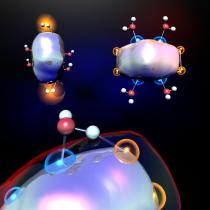The artificial water splitting systems that exist today are not very efficient and sometimes the loss of additional chemicals is required for their full operation. In this context, the development of new and efficient methods for splitting water is extremely important

The development of efficient systems for splitting water into hydrogen and oxygen, fission driven by sunlight, is among the most important challenges facing science today, and is supported by the possible and long-term ability of hydrogen gas to be used as a clean and sustainable fuel. However, artificial systems that exist today are not very efficient and sometimes the loss of additional chemicals is required for their full operation. In this context, the development of new and efficient methods for splitting water is extremely important.
Now, a unique approach developed by Professor David Milstein and his colleagues from the Department of Organic Chemistry at the Weizmann Institute, provides an important step in overcoming this challenge. During their research, the team demonstrated a new type of chemical bonding between oxygen atoms and even managed to define the mechanism responsible for it. In fact, it is the production of gaseous (molecular) oxygen through the creation of a chemical bond between two oxygen atoms originating from water molecules, the same molecules that previously formed the "bottleneck" of water splitting processes. The research findings were recently published in the prestigious journal Science.
Nature, using a completely different route, developed a very efficient process: photosynthesis - performed by plants - which is the source of all the oxygen on earth. Despite the many advances in understanding the processes and components of photosynthesis, a complete understanding of this system still does not exist. Extensive worldwide efforts have been invested in the development of artificial photosynthetic systems based on metallic couplings used as catalysts - but the success of these systems is still very little.
The new approach recently developed at the Weizmann Institute is divided into a sequence of reactions, leading to the release of hydrogen and oxygen as a result of successive stages driven by heat and light energy, and mediated by a unique component - a special metallic coupling developed by Milstein's group in a previous study. Moreover, the couplet they developed - a metallic couplet whose core is the atom ruthenium - is a "smart" couplet in which both the metallic center and the organic groups attached to it cooperate together when splitting the water molecules.
The team discovered that when mixing the conjugate with water, the chemical bonds between the hydrogen and oxygen are broken, when one hydrogen atom binds to the organic part while the other atom, together with an oxygen atom (together a hydroxyl group, OH) binds to the metal atom.
This adapted version of the clutch provides the basis for the next stage of the process - the "heat stage". When the water solution is heated to one hundred degrees Celsius, hydrogen gas begins to be released from the coupling - hydrogen which is a source of clean fuel.
However, the most interesting part is the third stage "the light stage", explains Milstein. "When we exposed this third conjugate to light at room temperature, not only was oxygen gas emitted, but the metallic conjugate returned to its original state so that it can be recycled for more and more reactions of this type."
These results are even more noteworthy if we remember that the creation of a chemical bond between two oxygen atoms following an artificial metallic coupling is an extremely rare event, and until today it was not clear if it could actually occur. In addition to this, Milstein's group also succeeded in identifying an unprecedented and original mechanism for this process. Additional experiments indicated that during the third stage, the light provides the necessary energy that causes two hydroxyl groups to join together to form hydrogen peroxide (H2O2), which quickly decomposes into an oxygen atom and a water molecule. "Since hydrogen peroxide is considered an unstable compound, scientists have always ignored this phase because they judged it to be improbable; But we proved otherwise," explains Milstein. Moreover, the team provided proof that shows that the bond between the two oxygen atoms was formed in the same atom - and not between oxygen atoms originating from separate atoms, as they believed until now - and that the origin of this bond is in the same metallic center.
Discovering an effective artificial catalyst for splitting water using light energy into oxygen and hydrogen is a main goal in the research of clean and renewable energy sources. Until now, Milstein's group has demonstrated a mechanism for the creation of oxygen and hydrogen from water without the need for the loss of additional chemicals, through individual steps using light. In the next step, the researchers plan to put these steps together to create an efficient catalytic system that will advance the extensive research being conducted in this important area of alternative energies.
